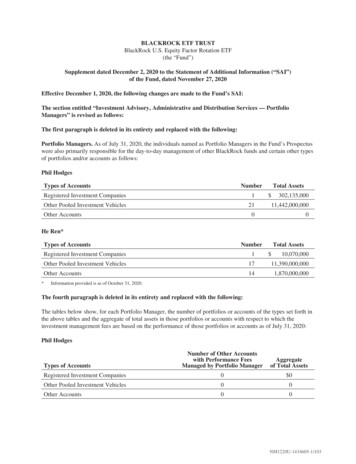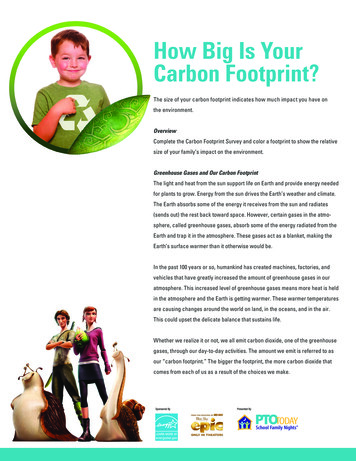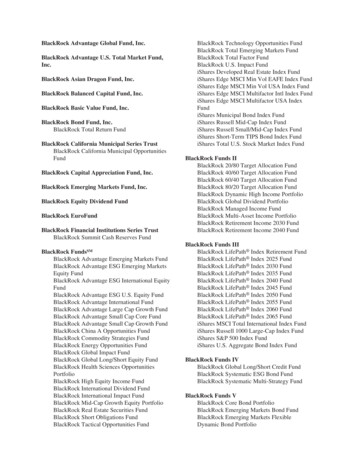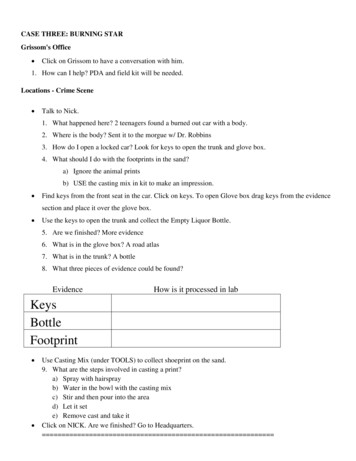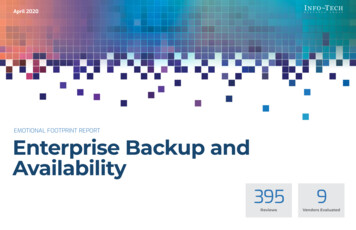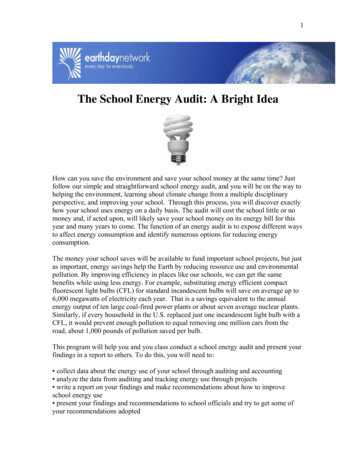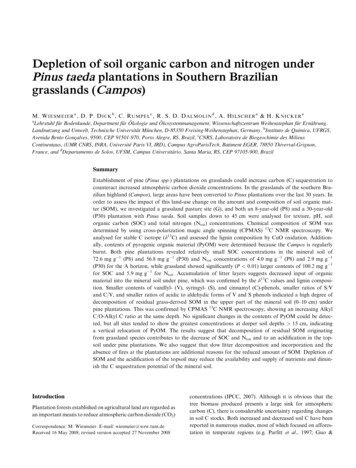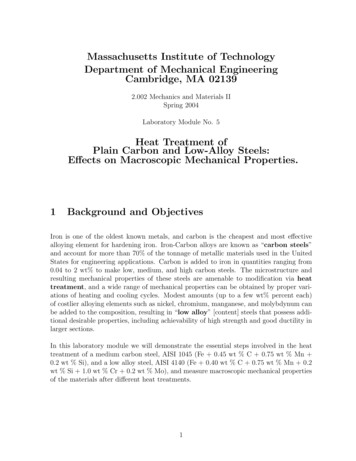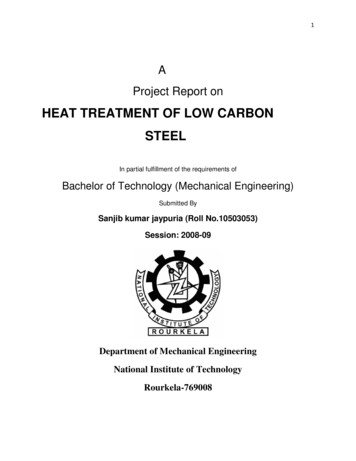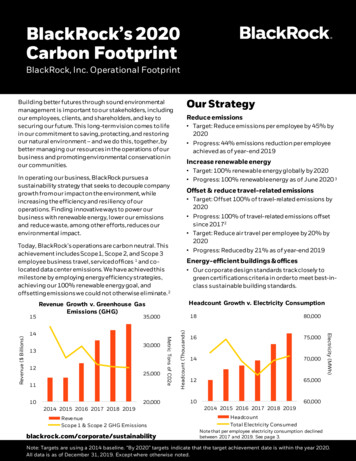
Transcription
BlackRock’s 2020Carbon FootprintBlackRock, Inc. Operational FootprintOur StrategyBuilding better futures through sound environmentalmanagement is important to our stakeholders, includingour employees, clients, and shareholders, and key tosecuring our future. This long-term vision comes to lifein our commitment to saving, protecting, and restoringour natural environment – and we do this, together, bybetter managing our resources in the operations of ourbusiness and promoting environmental conservation inour communities.Reduce emissions Target: Reduce emissions per employee by 45% by2020 Progress: 44% emissions reduction per employeeachieved as of year-end 2019Increase renewable energy Target: 100% renewable energy globally by 2020 Progress: 100% renewable energy as of June 2020 3In operating our business, BlackRock pursues asustainability strategy that seeks to decouple companygrowth from our impact on the environment, whileincreasing the efficiency and resiliency of ouroperations. Finding innovative ways to power ourbusiness with renewable energy, lower our emissionsand reduce waste, among other efforts, reduces ourenvironmental impact.Offset & reduce travel-related emissions Target: Offset 100% of travel-related emissions by2020 Progress: 100% of travel-related emissions offsetsince 20172 Target: Reduce air travel per employee by 20% by2020Today, BlackRock’s operations are carbon neutral. Thisachievement includes Scope 1, Scope 2, and Scope 3employee business travel, serviced offices 1 and colocated data center emissions. We have achieved thismilestone by employing energy efficiency strategies,achieving our 100% renewable energy goal, andoffsetting emissions we could not otherwise eliminate. 2Energy-efficient buildings & offices Our corporate design standards track closely togreen certifications criteria in order to meet best-inclass sustainable building standards.Headcount Growth v. Electricity ConsumptionRevenue Growth v. Greenhouse GasEmissions (GHG)30,000131225,000111020,0002014 2015 2016 2017 2018 2019RevenueScope 1 & Scope 2 GHG 0,0001675,0001470,0001265,00010Electricity (MWh)14Headcount (Thousands)35,000Metric Tons of C02eRevenue ( Billions)15 Progress: Reduced by 21% as of year-end 201960,0002014 2015 2016 2017 2018 2019HeadcountTotal Electricity ConsumedNote that per employee electricity consumption declinedbetween 2017 and 2019. See page 3.Note: Targets are using a 2014 baseline. “By 2020” targets indicate that the target achievement date is within the year 2020.All data is as of December 31, 2019. Except where otherwise noted.
Our ApproachElectricityWe have set emissions reduction targets for our globaloperations and data centers that we have been striving toachieve in 2020. These targets reflect our commitment toreducing the impact of our operations on the environment.In support of our commitment to transparency, BlackRockhas been a respondent to the CDP Climate Change surveysince 2013. We obtain third-party verification for ourScopes 1 and 2 emissions, as well as for our Scope 3business travel, employee shuttles, fuel- and energyrelated activities (FERA) and waste GHG emissions dataand collection process.Business TravelFor the year-ended 2019 and years prior, travel was asignificant source of carbon emissions for BlackRock. Since2017 we have elected to offset 100% of our travel-relatedemissions. 2 We have also reduced air travel per employee by21% as of year-end 2019. We attribute this reduction, inpart, to our ongoing investment in our video conferencingcapabilities, helping to make remote meetings botheffective and practical. In 2020, the investments we havemade in technology proved beneficial to BlackRock’sresilience during the COVID-19 pandemic (see SustainingBlackRock Through COVID-19 for more information) andwill also serve to reduce emissions from employee businesstravel. We are evaluating the implications for ourenvironmental sustainability strategy going forward.Electricity is also a large source of our carbon emissions.Since we began tracking electricity use in 2014, ourelectricity consumption has decreased by 1% despite a15% expansion in square footage and a 40% increase inheadcount. We accomplished this through theconsolidation of our data centers, retrofitting for LEDlighting, redesigning our office space use and adjusting ourheating, ventilation, and air conditioning (HVAC) systems tomore closely correlate to occupancy.Renewable EnergyRenewable energy has zero carbon emissions, whichenables us to reduce our energy-related emissions. We havemade it a priority to not only become more energy efficient,but also to ensure that the energy we purchase comes fromclean sources wherever possible. Our support for cleanenergy goes hand in hand with reducing our carbonfootprint and BlackRock’s position as one of the world’slargest investors in renewable energy assets. By increasingthe efficiency of our operations and buying both renewablepower and environmental attribute credits where we do nothave operational control to procure our own energy, we haveachieved our 100% renewable energy goal to match 100%of our global electricity use with renewable energy.Progress Towards Select 2020 GoalsCategorya.b.c.GoalsProgressto Date a2020 Goal bEmissionsReduce facility location-based GHG emissions(electricity, stationary combustion, andrefrigerants) per full-time employee44%45%Renewable EnergyMatch same amount of renewable electricity (inMWh) as the electricity that our global operations,including data centers consume annually100%100%ElectricityReduce absolute global electricity consumption1%18%Air TravelReduce air travel per employee21%20%PaperReduce global paper consumption44%25% cWasteIncrease global waste diversion from landfill48%75% cAs of December 31, 2019 unless otherwise noted2020 goals are using a 2014 baseline unless otherwise notedUses a 2017 baseline2
Data Centersand standard double-sided print settings on all copiers.Data centers are integral to supporting our operationsglobally. We have worked to make our data centers amongthe most efficient in the industry by designing, building andoperating them to maximize efficient use of energy, waterand materials4. In addition, our data centers are powered byhydro-power.WastePaperIn 2017, we set a 2020 paper reduction target of 25%which we achieved and have now surpassed. Since webegan tracking paper in October 2017, we have reducedpaper use by 44% as of December 2019. We attribute thisreduction to a heightening of awareness, swipe technologyBlackRock began tracking waste in 2017. We facechallenges from local waste practices in some cities inwhich we operate that have limited or no waste diversionpractices. Additionally, as primarily a tenant in multi-tenantbuildings, we are reliant on data provided by landlords’waste haulers, which is typically less rigorous than ourpreferred standards. Nonetheless, employees areencouraged to use less and recycle more through training,signage and office-wide “Green Team” initiatives. We alsocarefully consider what products are brought into ouroffices. As of year-end 2019, we have reported a 48%diversion rate of waste from landfills.Environmental Indications201420152016201720182019% .02.4(33%)Total Electricity Consumed ricity Consumed per Emploee(MWh per e ( millions ) aHeadcount (average Full-Time Employees &Contingent Workers) bGreenhouse Gas (GHG) EmissionsScope 1 GHG Emissions c(metric tons of CO2e)Scope 2 GHG Emissions d(metric tons of CO2e)Total Scope 1 & Scope 2 GHG Emissions(metric tons of CO2e)Total Scope 1 & Scope 2 GHG Emissions perRevenue(metric tons of CO2e per 1 million in revenue)Facilities CO2e per Employee e(metrics tons of CO2e per employee)Scope 3 Business Travel(metrics tons of CO2e)Scope 3 Business Travel per Employee(metrics tons of CO2e per employee)Electricitya.b.c.d.e.f.2015 information reflects accounting standards prior to the adoption of the new revenue recognition standard. 2016 to 2019information reflects the adoption of the new revenue recognition standard. For further information, refer to Note 2, Signifi cantAccounting Policies, in the consolidated financial statements in our 2019 Form 10-K.Headcount figures include all full-time employees and contingent workers. We take track headcount monthly and at year end takethe average across 12 months to more accurately reflect office occupancy. These figures differ from what is reported in our F orm10-K filing, which shows the total number of employees excluding contingent workers.Includes natural gas, distillate fuel, private aviation and refrigerants.Location-based method.Facilities CO2e includes location-based electricity, distillate fuel, natural gas, private aviation and refrigerants.Percentage change versus 2014. Calculations are using exact figures, so percentage change calculations using the roundedfigures above may not tie.3
Green Team NetworkGreen Teams are employee-led organizations in BlackRockoffices that provide employees with a forum to connectaround a shared interest and passion for the environment,create and engage in sustainability initiatives, share bestpractices, and steward conservation efforts. The membersof the Green Team Network are critical in bringing about amore sustainable culture at BlackRock and in ourcommunities. Today, 46 offices host Green Teams withnearly 2,300 employees participating. The Green Teamsundertake initiatives in partnership with our facilities teamincluding reducing single-use plastic in our office pantries,reducing paper use and waste, and planting nearly 12,000trees during the 2019-2020 planting season.In 2020, in light of a remote work environment due to theCOVID-19 pandemic, the Green Team Network ran twoemployee engagement campaigns to encourageconservation at home. The Do One Thing campaignfocused on six things employees could do to reduce theirimpact on the environment at home, including adjustingwater heater settings, unplugging unused electronics,getting educated on environmental issues, and reducingmeat consumption. Over 1,300 pledges were made toadopt one or all of the behaviors. The Green Team Networkalso ran a “Plastic Not Fantastic” campaign suggestingeight ways employees could reduce their plastic use athome.Social ImpactThrough our Social Impact efforts, we are committed tosupporting our communities, particularly as COVID-19 hasexacerbated social inequalities and hardship for millions ofpeople. In February 2020, BlackRock made a charitablecontribution of its remaining 20% stake in PennyMacFinancial Services, Inc. to The BlackRock Foundation, anewly established corporate foundation, and the BlackRockCharitable Fund, which was established in 2013. Thecontribution will provide long-term funding for the firm’sfuture philanthropic investments and partnerships focusedon promoting sustainability and economic mobility, andbuilding a financial safety net for underserved andunderemployed people.BlackRock Social Impact team’s employee engagementportfolio supports a number of accelerator programs thatidentify social entrepreneurs with disruptive and innovativeideas to address global social challenges. The acceleratorprograms have sub-portfolios of climate-focusedentrepreneurs supported by BlackRock’s grantee partners,including: the Echoing Green Climate Fellowship and theDraper Richards Kaplan Environment & Climate Fellows(Clean Energy Trust, Cloud to Street, GreenWave,OceanMind, BoxPower).E-Delivery AdvocacyBlackRock has long advocated for the electronic delivery offund and retirement plan documents as the defaultmechanism for communication with investors. E-delivery isenvironmentally friendly, as it reduces the use of paper andrelated printing and mailing resources. In addition, edelivery provides cost savings for investors and makes iteasy for individuals to receive information in real time ontheir computers or mobile devices. In the US, the SEC hastaken positive steps to facilitate e-delivery of mutual fundshareholder reports through the adoption of Rule 30e-3,which allows Registered Investment Companies to transmitshareholder reports electronically (subject to certainrequirements). The Investment Company Instituteestimated that the adoption of Rule 30e-3 would save 1.87million trees annually.5 We have been encouraging theDepartment of Labor to take similar actions for the deliveryof retirement plan documents. In Europe, as new legislativeinitiatives have been brought in, we have sought tomaximize the opportunities for digital dissemination. Forexample, we produce around 50,000 Undertakings for theCollective Investment in Transferable Securities (UCITS)Key Information Documents (KIDs) a year in multiplelanguages and we use our website as our primary deliverymechanism. We have also consistently advocated for keyinformation disclosure documents, including UCITS,packaged retail investment and insurance-based products(PRIIPs) and pan-European personal pension products(PEPPs) to be designed on a digitally friendly basis ratherthan on a paper-basis.
Endnotes1.2.3.4.5.Serviced Offices are offices and co-located data centers for which landlords have full operational control.BlackRock’s support for this initiative is made via grants recommended to and paid by the BlackRock Charitable Trust, a donor-advised fund.In June 2020, we achieved our 100% renewable energy goal to match the same amount of renewable electricity as the electricity that our global operations(including data centers) consume annually through procuring renewable energy directly where possible and through purchasing environmental attributecredits where we do not have operational control or renewable energy is not available. We contract directly for renewable energy wherever possible(approximately 50%) and where we do not have operational control to procure our own energy, we purchase environmental attribute credits as a means ofachieving our 100% renewable goal.Our data centers consume 75% less energy than the typical enterprise data center does for cooling and electrical support. Our enterprise data centers operateat a PUE of 1.1 and 1.2; the industry average data center PUE is 1.8.Investment Company Institute, Letter to SEC, Proposed Rule 30e-3’s Vital Importance to Fund Shareholders (Jul. 8, 2016), available .pdf at 4.Important NotesThis document includes non-financial metrics that are subject to measurement uncertainties resulting from limitations inherent in the nature and the methods usedfor determining such data. The selection of different but acceptable measurement techniques can result in materially differe nt measurements. The precision ofdifferent measurement techniques may also vary. The information set forth herein is expressed as of September 2020 and BlackR ock reserves the right to update itsmeasurement techniques and methodologies in the future. 2020 BlackRock, Inc. All Rights Reserved. BlackRock is a registered trademark of BlackRock, Inc. or its subsidiaries in the United States and elsewhere. All other trademarks are those oftheir respective owners.
Business Travel For the year-ended 2019 and years prior, travel was a significant source of carbon emissions for BlackRock. Since 2017 we have elected to offset 100% of our travel-related emissions.2 We have also reduced air travel per employee by
